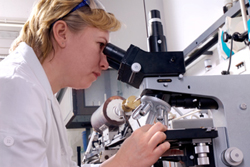Test for E. coli under field work conditions
Around 10% of E. coli are lactose negative and are not counted if a technique is used that only identifies lactose-positive colonies. In order to overcome these challenges the ANTRES project developed a simple and cost-effective procedure for identifying E. coli under field conditions. The test detected the enzyme Beta-D-glucuronidase by using the substrate 4-methylumbelliferyl-Beta-D glucuronide (MUG), producing the compound 4-methylumbelliferone. A positive result was indicated by a strong blue fluorescence under UV light. Detection of the enzyme is important because it is produced by nearly all strains of E. coli. Furthermore, those other bacteria which produce the enzyme do not grow in the same sort of media as used for E. coli. The test developed by the ANTRES project was much cheaper than previous tests which use culture media which has had MUG added. The use of microtitre plates allowed a large number of strains to be analysed quickly and simply. The technique was found to be suitable for use under field conditions. One of the major benefits of the new method is that it greatly reduces the number of false positives obtained. The test enabled accurate identification of E. coli amongst lactose fermenting colonies. During field trials in Bolivia and Peru the MUG-test was carried out for several coliform and atypical colonies. The result was a major improvement in the ability of local laboratory staff to classify isolates grown on plates of McConkey agar.







